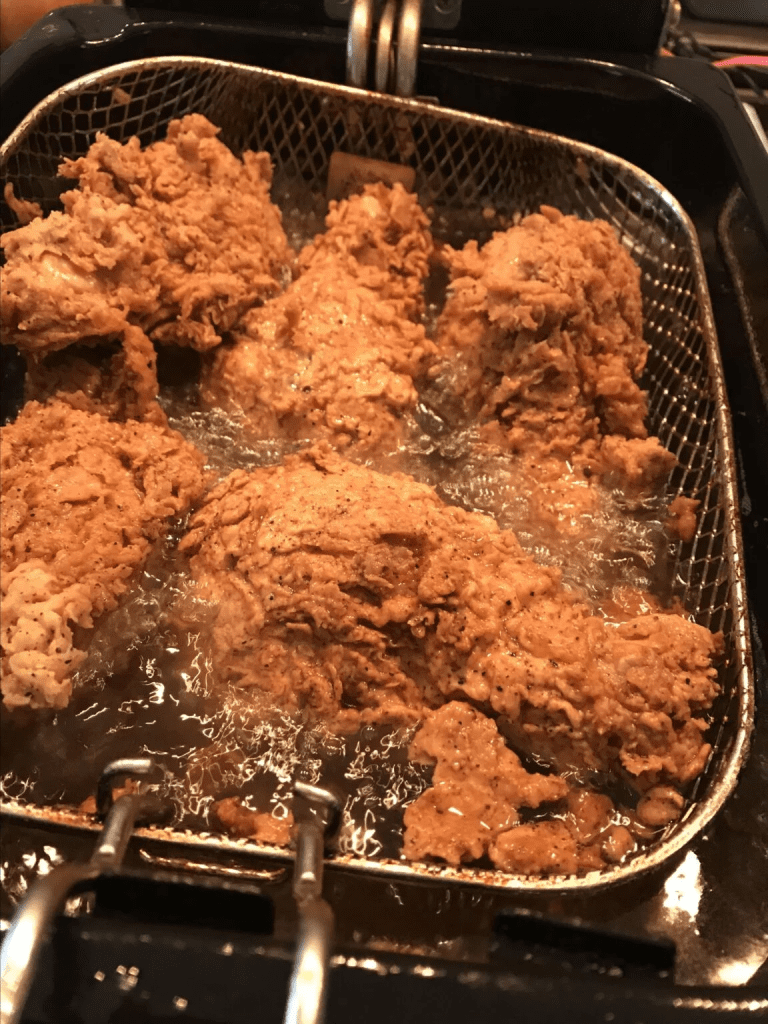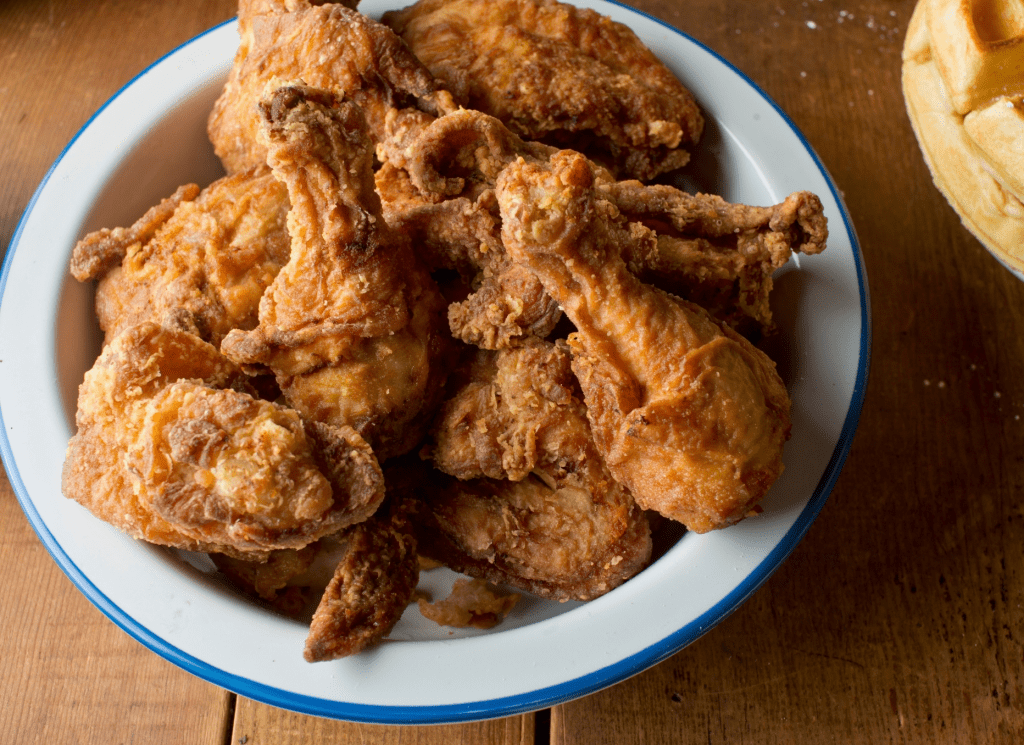Fried chicken is a beloved comfort food enjoyed around the world.
However, making the perfect fried chicken can be a challenge. From achieving the right level of crispiness to infusing flavour into the meat, several factors can make or break a fried chicken recipe.
Luckily, with some insider tips and techniques, anyone can take their fried chicken game to the next level.
Let’s check the three secrets to improving your fried chicken recipe and make it a crowd-pleasing hit every time.
Secrets to Improving Fried Chicken
- A Salty Marinade
- Coating for the Crunch
- Double Fry It
Burned Chicken Secret #1 Marinade
Secret #1 for rescuing burned chicken lies in the marinade. When you accidentally overcook your chicken, and it turns out dry and tough, a flavorful and moisture-rich marinade can work wonders.
Start by selecting a marinade that complements your preferred flavor profile—a zesty citrus blend, a savory herb and garlic mix, or a sweet and spicy sauce. To save the burned chicken, slice it into smaller pieces or shred it to maximize the surface area for the marinade to penetrate.
Place the chicken in a container or resealable bag, then pour the marinade. Seal it tightly and refrigerate for at least an hour, allowing the flavors to infuse and the chicken to regain some moisture.
When you’re ready to reheat the chicken, use gentle methods like low heat on the stove or a microwave with a damp paper towel to prevent further drying. It will look like Zus restaurant chicken menus.
Thanks to the marinade, your once-burned chicken will return to life with improved tenderness and a burst of delicious flavor.

How It Works
Most Southern signed chicken plans start with a shower in a prepared fried chicken marinade, whether it’s buttermilk, milk, eggs, or pickle juice.
Adding salt to this mix can help your chicken stay clammy. This works in precisely the same way as brackish water.
Standard salty water is a salt answer broken up in water (around 6% salt by weight). As chicken sits in salty water, the salt breaks up proteins in the meat’s muscle structure, releasing it and permitting it to hold more dampness as it cooks.
Tenderized chickens lose 30 to 40% less moisture than un-tenderized chickens.
Instructions to Do It

- To make brackish water with a 6% salt fixation, I add a large portion of an ounce of salt for some marinade. This means around one and a half tablespoons of Diamond Crystal legitimate salt per cup, one tablespoon of Morton’s natural salt per cup, or two teaspoons of common table salt per cup.
- I’ve recorded that I never use saline solution for my chickens or turkeys as a standard saline solution can water down the meat. For plans that currently have a marinade step worked in, you can profit from adding the right measure of salt to that marinade. This secret will improve your fried chicken recipe.
Seared Chicken Secret #2: Coating For The Crunch
Secret #2 for achieving the perfect seared chicken is about creating that irresistible crunch on the outside. The key to a fantastic coating lies in a few crucial elements.
Firstly, ensure your chicken pieces are dry before coating them. This helps the coating adhere better and results in a crispier texture.
Next, consider using a combination of flour and breadcrumbs seasoned generously with salt, pepper, and any desired herbs or spices.
For an even crunchier finish, try double-dipping your chicken: dip it in beaten egg, then coat it in the seasoned flour mixture again.

Finally, don’t forget to let your coated chicken rest for a few minutes before cooking; this allows the coating to set, enhancing that delightful crunch when you sear it to perfection. With these tips, you’ll have a mouthwatering, crispy-coated seared chicken that will leave everyone asking for your secret recipe.
How It Works
Have you ever seen that when you’re breading a significant gathering of fried chicken, the pieces you bread at the end come out crisper, crunchier, and with more surface area than the ones you bread around the beginning?
This is because as you work, pieces of marinade dribble off the chicken and into the dry-prepared flour combination, framing little clusters that then, at that point, stick to ensuing bits of chicken.
As the chicken fries, these bunches dry out brown and fresh, adding flavor and crunch. So why not exploit this peculiarity by adding dampness to your dry-prepared flour combination?
Step-by-Step Instructions to Do It
- For some digging flour called for in the formula, I sprinkle around two tablespoons of marinade. After showering the marinade on top, I then, at that point, work it into the flour with my fingertips or a race before adding the chicken parts to coat them.

- Then, add a blend of herbs and spices such as garlic powder, onion powder, smoked paprika, and cayenne pepper. The exact amounts will depend on your preference, but a good starting point is one teaspoon of each.
- To create a crispy coating, it’s important to coat the chicken in the flour mixture twice. After the first coating, dip the chicken back into the brine before covering it again. This will help to create a more substantial and crunchier coating. Attempt it. Your seared chicken will be crunchier than at any other time.
Seared Chicken Secret #3: Double-Fry It
Secret #3 in achieving the perfect seared chicken is a technique known as double-frying. This method takes your chicken’s crispiness to the next level.
After the initial sear, which cooks the chicken through and provides a nice crunch, the double-fry adds an extra layer of crispy perfection. To execute this secret, carefully lower your seared chicken pieces back into hot oil for a second round of frying. The key is to ensure the oil is at the right temperature, typically around 350-375°F (175-190°C).
This rapid, hot fry will create a beautifully golden and incredibly crispy exterior that’s hard to resist. Be cautious when handling hot oil, and use a kitchen thermometer to monitor the temperature.
With the double-fry technique, you’ll elevate your seared chicken to a new level of crunchiness, making it a culinary masterpiece that will surely impress.
How It Works
Fricasseeing eliminates dampness from the outside and leaves it crunchy. However, you can only broil it as long as it takes to cook the meat. Leave the chicken in excessively long, and you’ll wind up with a fresh outside, however dry, overcooked beef.

By cooking once, allowing the chicken to chill, and then singing the next time again, you end up with extra crunchy covering and meat that is still delectable.
Instructions to Do It
- Fried your chicken, of course, then let it rest at room temperature for at least thirty minutes before fricasseeing it again. You can even chill and refrigerate the chicken short-term and fry it a second time before eating it.
- This is a magnificent method for restoring seared chicken extras (as though something like this exists), and your chicken will wind up stunningly better on a subsequent day.
- After frying, let the chicken rest on a wire rack for a few minutes before serving. This will help ensure the coating stays crispy and the chicken remains moist.
FAQs
What are some common mistakes people make when frying chicken?
Some common mistakes include using the wrong oil temperature, overcrowding the frying pan, and not seasoning the chicken enough.
How can I make my fried chicken more flavorful?
One secret to making flavorful fried chicken is to marinate the chicken in a mixture of buttermilk and spices before frying. Another trick is to season the flour or breading mixture with spices or herbs.
How can I achieve a crispy crust on my fried chicken?
To achieve a crispy crust, using the right combination of flour and seasonings in the breading mixture is essential. Another critical factor is to fry the chicken in hot enough oil (around 350-375°F) and to avoid overcrowding the frying pan.
Can I use different types of flour for the bread mixture?
You can experiment with different types of flour, such as all-purpose flour, cornmeal, or even almond flour, to achieve a different texture and flavor.
Can I use an air fryer to make fried chicken?
An air fryer can make fried chicken with less oil and a healthier option. However, it may not have the same crispy texture as traditional fried chicken.
How long should I marinate the chicken before frying?
Marinating the chicken for at least 30 minutes or overnight for maximum flavor is recommended.
What can I do if the chicken is overcooked or undercooked?
The chicken may be challenging and dry if it is overcooked. If it’s undercooked, it may be unsafe to eat. It’s essential to use a meat thermometer to ensure the chicken reaches an internal temperature of 165°F before serving.
Can I use different spices and seasonings in the bread mixture?
You can experiment with different spices and seasonings to create your unique flavor profile. Some popular options include cayenne pepper, paprika, garlic powder, and onion powder.
